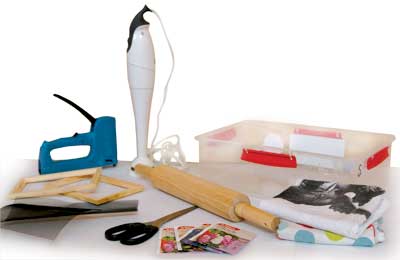At home
Make seeded paper
Sam Judd

My parents always told me to never underestimate the power of a handwritten letter. People love receiving personal notes in the mail and you can make it even more special by giving the gift of flowers too.
Seeded paper not only recycles your old paper, it’s a great activity to do with the kids and leaves a lasting memory – when planted in the garden, the flowers that grow out of it can be enjoyed year after year by both the recipient and bees.
You’ll need

- 2 x old photo frames of equal size – you don’t need the glass, so it is the perfect use for that broken frame you have lying around; or you can purchase new ones from The Warehouse for around $2 each
- Wire mesh – this is available at most hardware stores for around $13 per metre
- Stick blender or food processor
- 3 x old tea towels
- Rolling pin
- Scissors
- Staple gun
- Large plastic surface for drying your paper on
- A deep dish that is larger than your photo frames
- Seeds – pick something that will provide a beautiful bloom and sustenance for the bees. Make sure the seeds are small so that they won’t protrude from the paper once it is dry
- Essential oil (optional for a beautiful aroma – perfect for love letters!)
- Petals (optional – makes for a nice decoration)
Your step-by-step guide
Step 1 Prepare your paper

Tear up your scrap paper into postage stamp-sized pieces and place in your deep dish. Tearing the paper gives a better result than cutting. Cover the paper with water and leave to soak for a few hours.
Step 2 Make your frame

Cut a piece of the wire mesh to fit your frame and staple it taut across one of the frames. Cut another piece of mesh so that it is just larger than your frame.
Step 3 Make the pulp

Using your blender, carefully puree the soaked paper and water mix into a porridge-like pulp. Fill your large container with water to about 7cm and add the pulp mix. Sprinkle the seeds into the pulp mix and add the essential oil and petals if you want. Mix thoroughly.
Step 4 Catch the pulp


Sandwich the frame together in the following order: the frame with mesh attached on the bottom (with the mesh on the top so you have a flat surface), then the loose piece of mesh, and then the empty frame on top. Stir the pulpy water, grip the frame together firmly on both sides, then in one movement slide the frame into the pulpy water until it is horizontal. Lift the frame carefully out of the water (trying to keep it as level as possible). You should have a fine even covering of pulp on the mesh.
Step 5 Let it drain

Hold it above the dish to let the water drain. If it is uneven or too thick (or thin) then try again. Sometimes you may need to thicken the mix by adding more paper pulp or thin it down by adding more water.
Step 6 Lay it out

Remove the frame from the top of your sandwich and carefully flip the wire mesh with the pulp on it upside down on to your piece of plastic.
Step 7 Squeeze

Lay the tea towel on top then with the rolling pin, gently squeeze out the excess water.
Step 8 Dry

Peel off the mesh and leave to dry for at least 24 hours. Once dry you can write or even print on the paper. All your lucky recipient needs to do is throw it on the garden and wet with a hose, then watch the flowers grow!
Tips and tricks
- Ask at the garden centre which flowering plants have small seeds.
- Add essential oils, food colouring or petals and leaves to the mix to further personalise your paper.
- If you want a letterpress effect, then press the paper on top of an object (such as a cardboard heart) and it will be embossed in the paper once it has dried.
- Try drying the paper on different surfaces to achieve different textures.
